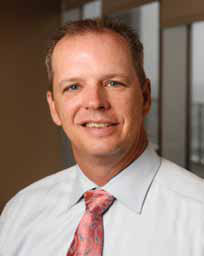Harman’s Augsburger Looks Past The Recession

NORTHRIDGE, CA—That which creates disruption also creates opportunity, and many systems specialists have found ways to not only maintain but also grow their business in spite of overwhelming economic challenges recently.
Blake Augsburger, Harman Professional division president and CEO
That’s a story that resonates within Harman Professional, says division president and CEO Blake Augsburger, who has presided over expansion in most of Harman’s market sectors during the last two years, including, notably, the installed and touring systems sector. Reviewing the milestones of the past 24 months heading into the InfoComm show next month, Augsburger noted market share gains, continued profitability, and new product and systems innovation in the sector.
“We focused our product development and marketing efforts on the commercial side of systems integration: mass notification systems, PA systems, transportation hub and other paging systems, distributed audio and networking, and other systems for fixed-venue and concert touring sound systems. And we did so on a global basis,” Augsburger said, noting several significant installations around the world.
“This [growth] is taking place on a global scale, as well,” Augsburger said. In fact, much of the last two years has been spent restructuring Harman’s organization, much of it on a geographical basis. New offices were opened in Kuala Lumpur and Puerto Rico in early 2009; and a new European support office will open in Potter’s Bar, U.K. in Q3 2010. Harman has also initiated a new software development office in Bangalore, India, and a new engineering center in Shenzhen, China.
Harman has put the same amount of energy restructuring its domestic operations. In North America, JBL’s manufacturing has been centralized in Tijuana, Mexico while its famed R&D center remains in Northridge, CA. On the commodities level, Harman has also consolidated its purchasing procedures. From semiconductors and LCD screens to pencils and paper, Harman can now leverage the buying power across sectors and brands with the rest of the $3.3 billion Harman International corporation.
“We think the Federal stimulus finding has been beneficial to us and to the commercial installation sector as a whole, helping to expand and renew the country’s infrastructure,” Augsburger said.
A daily selection of the top stories for AV integrators, resellers and consultants. Sign up below.
The future of systems design and integration is the network, and Harman brands have collectively been pioneers in that arena, Augsburger illustrated: “People may not realize that we’ve been working on networked audio and control for two decades now, beginning with Crown amplifiers 17 years ago. We began investing heavily in HiQNet seven years ago, as we saw the influence of IT over AV gaining ground.”
Harman is a founding member of the AVnu Alliance, an industry forum that promotes the adoption of the IEEE 802.1 Audio/Video Bridging (AVB) standard. “AVB eliminates the drawbacks that networks have that affect bandwidth and jitter,” Augsburger explained. “AVB lets users precisely predict time synchronization of audio signal on the network, and that’s going to further the trend of IT and AV becoming one thing, and blur the lines between the systems contractors who work in audio, video, and IT.” Augsburger hinted that video products might also be part of the Harman’s future format line-up.
The AVNetwork staff are storytellers focused on the professional audiovisual and technology industry. Their mission is to keep readers up-to-date on the latest AV/IT industry and product news, emerging trends, and inspiring installations.
